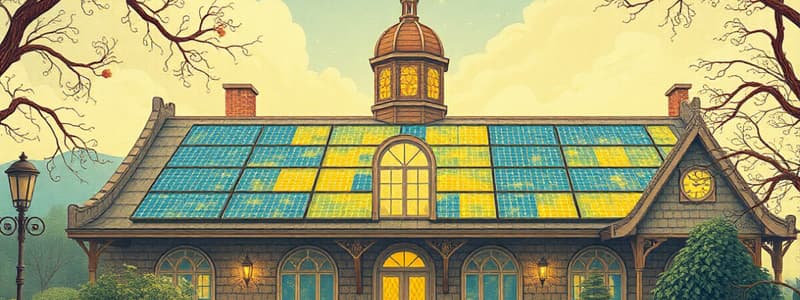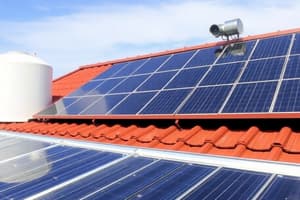Podcast
Questions and Answers
What are the primary benefits of solar thermal systems?
What are the primary benefits of solar thermal systems?
- Environmental and economic
- Energy efficiency and cost savings
- Reduced carbon emissions and lower energy bills
- All of the above (correct)
What are the types of solar thermal collectors?
What are the types of solar thermal collectors?
- Open circuit and closed circuit collectors.
- Flat plate, evacuated tube and heat pipe collectors.
- Natural circulation and forced circulation collectors.
- Glazed flat collectors, vacuum collectors, and flat unglazed collectors. (correct)
What is the function of the absorber plate in a solar thermal collector?
What is the function of the absorber plate in a solar thermal collector?
- To regulate the flow of the working fluid.
- To transfer the heat to the working fluid.
- To store the thermal energy collected.
- To absorb solar radiation and convert it into heat. (correct)
A selective coating on the absorber plate enhances heat absorption and reduces heat loss.
A selective coating on the absorber plate enhances heat absorption and reduces heat loss.
What is the primary function of the heat transfer fluid in a solar thermal system?
What is the primary function of the heat transfer fluid in a solar thermal system?
What are the main types of solar thermal systems based on fluid circulation?
What are the main types of solar thermal systems based on fluid circulation?
Natural circulation systems require a pump to circulate the heat transfer fluid.
Natural circulation systems require a pump to circulate the heat transfer fluid.
What is the primary function of the storage tank in a solar thermal system?
What is the primary function of the storage tank in a solar thermal system?
What are some common applications of solar thermal systems?
What are some common applications of solar thermal systems?
Solar thermal systems are best suited for locations with a high solar irradiance, consistent sunshine throughout the year.
Solar thermal systems are best suited for locations with a high solar irradiance, consistent sunshine throughout the year.
What factors influence the efficiency of a solar thermal collector?
What factors influence the efficiency of a solar thermal collector?
Solar thermal systems can only be used for producing hot water.
Solar thermal systems can only be used for producing hot water.
What is the key advantage of evacuated tube collectors compared to flat plate collectors?
What is the key advantage of evacuated tube collectors compared to flat plate collectors?
Heat pipe collectors are a type of evacuated tube collector that utilizes a phase change process for heat transfer.
Heat pipe collectors are a type of evacuated tube collector that utilizes a phase change process for heat transfer.
What are the key considerations for selecting the proper orientation and inclination of a solar collector?
What are the key considerations for selecting the proper orientation and inclination of a solar collector?
Shading of solar collectors can significantly reduce their ______ by blocking incoming solar radiation.
Shading of solar collectors can significantly reduce their ______ by blocking incoming solar radiation.
What are the primary considerations when choosing the connection method (series or parallel) between solar collectors?
What are the primary considerations when choosing the connection method (series or parallel) between solar collectors?
Series connection of solar collectors allows for higher flow rates but potentially greater heat losses.
Series connection of solar collectors allows for higher flow rates but potentially greater heat losses.
What are the key considerations for designing and installing a solar thermal system for domestic hot water production?
What are the key considerations for designing and installing a solar thermal system for domestic hot water production?
What is the function of the expansion vessel in a forced circulation solar thermal system?
What is the function of the expansion vessel in a forced circulation solar thermal system?
Thermal stratification in the storage tank is highly beneficial for maximizing the efficiency of a solar thermal system.
Thermal stratification in the storage tank is highly beneficial for maximizing the efficiency of a solar thermal system.
What are the primary differences between natural circulation and forced circulation solar thermal systems?
What are the primary differences between natural circulation and forced circulation solar thermal systems?
Solar cooling systems can be used for both heating and cooling applications.
Solar cooling systems can be used for both heating and cooling applications.
What are the key components of a forced circulation solar thermal system for space heating?
What are the key components of a forced circulation solar thermal system for space heating?
The f-chart method is a widely used tool for designing solar thermal systems.
The f-chart method is a widely used tool for designing solar thermal systems.
What is a primary goal of solar thermal system design?
What is a primary goal of solar thermal system design?
The efficiency of a solar collector can vary significantly based on the time of day and season.
The efficiency of a solar collector can vary significantly based on the time of day and season.
Which of the following factors can impact the overall efficiency of a solar thermal system?
Which of the following factors can impact the overall efficiency of a solar thermal system?
Flashcards
Solar Thermal System
Solar Thermal System
A system that harnesses solar radiation to produce thermal energy.
Auxiliary System
Auxiliary System
A system that provides backup heat when solar energy is insufficient, like a boiler or electric heater.
Storage
Storage
A component in a solar thermal system that stores thermal energy for later use, like a water tank.
Solar Collector
Solar Collector
Signup and view all the flashcards
User
User
Signup and view all the flashcards
Swimming Pool Heating
Swimming Pool Heating
Signup and view all the flashcards
Sanitary Water Heating
Sanitary Water Heating
Signup and view all the flashcards
Space Heating
Space Heating
Signup and view all the flashcards
Solar Cooling
Solar Cooling
Signup and view all the flashcards
Natural Circulation System
Natural Circulation System
Signup and view all the flashcards
Forced Circulation System
Forced Circulation System
Signup and view all the flashcards
Open Circuit System
Open Circuit System
Signup and view all the flashcards
Closed Circuit System
Closed Circuit System
Signup and view all the flashcards
Glazed Flat Collector
Glazed Flat Collector
Signup and view all the flashcards
Vacuum Collector
Vacuum Collector
Signup and view all the flashcards
Unglazed Flat Collector
Unglazed Flat Collector
Signup and view all the flashcards
Collector Efficiency
Collector Efficiency
Signup and view all the flashcards
Thermal Stratification
Thermal Stratification
Signup and view all the flashcards
Expansion Vessel
Expansion Vessel
Signup and view all the flashcards
Solar Circuit Control
Solar Circuit Control
Signup and view all the flashcards
Domestic Hot Water System
Domestic Hot Water System
Signup and view all the flashcards
Space Heating System
Space Heating System
Signup and view all the flashcards
Solar Fraction
Solar Fraction
Signup and view all the flashcards
f-Chart Method
f-Chart Method
Signup and view all the flashcards
Heat Loss Coefficient
Heat Loss Coefficient
Signup and view all the flashcards
Stagnation
Stagnation
Signup and view all the flashcards
Stagnation Temperature
Stagnation Temperature
Signup and view all the flashcards
Stagnation Protection
Stagnation Protection
Signup and view all the flashcards
Expansion Vessel for Solar Circuits
Expansion Vessel for Solar Circuits
Signup and view all the flashcards
Solar Cooling
Solar Cooling
Signup and view all the flashcards
Study Notes
Renewable Energy Technologies - Solar Thermal Systems
- Solar thermal systems collect and convert solar radiation into thermal energy using solar collectors.
- They reduce energy consumption from fossil fuels and the amount of carbon dioxide introduced into the atmosphere.
- Solar energy is intermittent in space and time, requiring integration with an auxiliary system.
- Benefits include environmental protection (reduced CO2 emissions) and economic advantages (favorable payback time).
System Components
- Collector: Captures solar radiation and heats a working fluid.
- Storage: Stores the collected heat for later use.
- Auxiliary System: Provides energy when solar input is insufficient.
- User: The end-user who utilizes the collected thermal energy.
Applications
- Heating of outdoor swimming pools: Required temperature: 25-27°C. Energy demand coincides with favorable solar radiation periods.
- Sanitary water heating: Required temperature: 45-60°C. Constant energy demand throughout the year.
- Space heating: Required temperature varies based on terminal type. Energy demand coincides with the least favorable solar radiation periods.
- Solar cooling: Required temperature >80°C. Energy demand coincides with favorable solar radiation periods.
Solar Thermal Market
- The market for solar thermal systems (glazed collectors) in EU27 and Switzerland has shown growth since 2002.
- Key countries in terms of market share include Germany and other top 6 countries (e.g., Austria, Spain, and France), followed by other EU countries and Switzerland
- Installation capacity per 1000 capita in key European countries has shown growth over the same period .
- Market shares for newly installed capacity in EU countries show varying degrees of market penetration, with Germany leading.
Solar Collectors
- Glazed flat collectors (covered): Use a transparent cover to trap heat.
- Vacuum collectors: Employ a vacuum to reduce heat loss.
- Flat unglazed collectors (uncovered): Absorb solar radiation directly and are suitable for lower temperatures.
Performance
- Efficiency of solar collectors depends on the reduced temperature (Tm-Ta)/G.
- Efficiency is affected by various factors such as the type of collector, the temperature of the working fluid, and the ambient temperature.
System Classifications
- Natural circulation systems: Use gravity-driven fluid flow.
- Forced circulation systems: Use pumps to circulate the fluid.
- Open circuit (direct): The system directly uses water needed by the user. Works in areas not prone to freezing.
- Closed circuit (indirect): Uses a separate solar circuit containing a different working fluid, which is then used to heat the water for the user.
- Different types use different materials, have different pressure drops etc., affecting performance, cost and suitability for various systems and applications
Components of a glazed flat collector
- Containment frame or box.
- Transparent glass cover.
- Absorbent plate
- Channels or tubes where heat transfer liquid flows
- Insulation
The Absorber Plate
- Typically made of copper, aluminum, or stainless steel.
- Coated with a selective coating for optimized absorption/reflection
- Comes with parallel or serpentine tubes.
The Selective Coating
- Absorbs solar radiation and reflects infrared radiation, improving efficiency.
- Minimizes heat emissions, maximizing energy absorption
Transparent Cover
- Low Iron content glass is used to enhance transparency at low wavelengths, crucial for solar radiation transmission, and is opaque to infrared radiation emitted by the plate.
Types of Absorber Plates
- Serpentine plate: Offers higher pressure drop, unsuitable for natural circulation systems, but provides turbulent flow.
- Parallel tube plate: Lower pressure drop, suitable for natural circulation systems.
Heat Transfer Fluid
- Must have good thermal properties, frost protection, and not be corrosive, or cause issues with collector components
- A 40% glycol mixture with water is a typical choice, ensuring low freezing temperature and good performance
- Glycol is incompatible with some metals, and percentage must be carefully controlled to ensure optimal viscosity.
Freezing points
- Various liquids used in solar systems have different freezing points, crucial for operation in cold climates
Viscosity of Fluids
- Viscosity of different fluids employed in collector circuits varies with temperature.
Energy Losses in the Collector
- The presence of air between the absorber plate and the glass cover in flat collectors results in greater heat losses.
Efficiency of the Collector
- Efficiency is the ratio of absorbed to incident energy
- Affected by various factors:
- Absorber plate and cover properties, temperature difference, wind, and amount of solar radiation
Collector Orientation and Inclination
- Collectors should face south in the Northern Hemisphere (north in the Southern Hemisphere).
- Optimal inclination depends on the latitude, ranging from 30-40° for domestic hot water to 60-70° for space heating.
- Inclination also impacts the angle of incidence and shading.
Collector Installation
- Can be installed on roofs (retrofitted or integrated) or as façade systems.
Collector Shading
- Solar height (elevation angle) affects shading.
- Calculations for shading must take into account solar height, collector inclination, and spacing between rows.
Collector Connection
- Systems can be wired in series (sequential) or in parallel (independent). Choices depend on the type of system and the design.
Flow in the Circuit
- High-flow systems use parallel connections and a higher flow rate.
- Low-flow systems use a combination of series and parallel connections with a lower flow rate and higher temperature variation.
Natural Flow System
- Employs natural convection due to density differences in the heated and unheated fluids inside the collector, storage tank, and pipes, eliminating the need for a pump.
- Storage tank must be higher than the collector, driving fluid circulation via density differences.
Forced Flow System
- Utilizes a pump for efficient fluid circulation regardless of temperature gradients or elevation.
- Can be installed anywhere
- More complex than natural systems, requiring a pump and an additional control system.
Thermal Stratification
- Thermal stratification in the storage tank is important in forced flow systems, promoting optimal heat transfer, maximizing heat collection and preventing undue temperature variations within the system.
- It needs a taller and narrower storage tank (H/D > 2.5)
Expansion Vessel
- Serves to accommodate volume changes of the fluid in the solar circuit due to thermal expansion and evaporation.
- It prevents damage to the system by isolating the fluid from the pressure increases.
- Should be strategically installed and properly sized to handle the temperature and pressure fluctuations in operation.
Solar Cooling System
- Solar cooling systems use an absorption cycle, including parts like a condenser, generator, vaporizer, and absorber.
Evaluation of Thermal Load and Energy Sizing
- Calculation of required solar fraction is crucial based on the average required energy and efficiency for various use cases, depending on systems specifications. Methods for calculation include f-Chart methods and empirical correlations. Tools and standards like EN 15316 can be used.
Calculation of Solar System Efficiency (EN 15316-4-3)
- Parameters necessary to calculate the efficiency of the system include the collector losses coefficient a1 and a2, the average solar irradiance (I), and the aperture area of the system (A)
Stagnation in Solar Collectors
- Occurs when the user cannot remove heat from the solar circuit for a prolonged period, leading to high temperatures, and potentially harming the system and requiring prompt addressing and correction of contributing factors.
- Prevention or mitigation systems are required
Studying That Suits You
Use AI to generate personalized quizzes and flashcards to suit your learning preferences.
Related Documents
Description
This quiz explores solar thermal systems, including their components, applications, and benefits. Learn how these systems convert solar energy into thermal energy and their role in reducing fossil fuel consumption and CO2 emissions. Test your knowledge on the functionalities of collectors, storage, and auxiliary systems.



